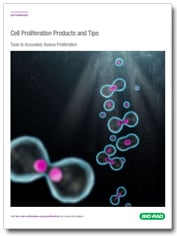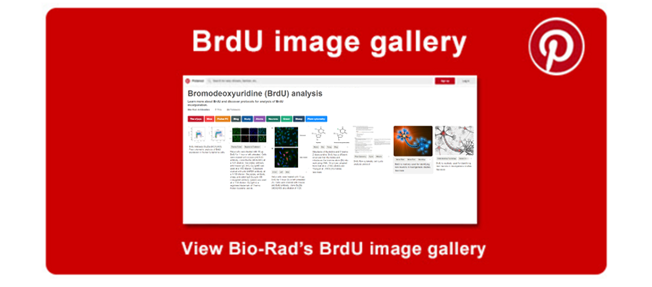Anti-BrdU Antibodies: A Widely Referenced Tool for Measuring Cell Proliferation
Application of Anti-BrdU Antibodies
The thymidine analog 5′-bromo-2′-deoxyuridine (BrdU) is extensively referenced in the scientific literature as a tool for determining the rates of cell proliferation, as dividing cells incorporate BrdU into newly synthesized DNA during the S phase of the cell cycle. Anti-BrdU antibodies, such as the Mouse Anti-BrdU Antibody, clone Bu20a (MCA2483) and Rabbit Anti-BrdU Antibody (AHP2405), are subsequently used to detect and visualize the incorporated BrdU. This is commonly done by immunodetection techniques such as flow cytometry, immunocytochemistry, and immunohistochemistry.
BrdU is a universal tool that has been successfully used for studies in evolutionary diverse organisms ranging from plants, fish, and invertebrates (such as the flatworm Macrostomum lignano) to vertebrates, including mammalian species (Caronia et al. 2010, Huang et al. 2013, Nagar et al. 2002, Verdoodt et al. 2012).
Limitations of BrdU as a research tool and its detection with anti-BrdU antibodies
Although BrdU has been successfully established as a tool in many biological systems, the use of BrdU and other thymidine analogs has its limitations. For example, BrdU cannot be readily incorporated into yeast DNA as yeasts lack thymidine nucleoside transporters and thymidine kinases, which are essential for the uptake and incorporation of exogenous thymidine (or its analogs) into newly synthesized DNA (Lengronne et al. 2001). To compensate for the absence of these critical proteins, Saccharomyces cerevisiae strains have been genetically engineered to express exogenous genes, such as the Herpes simplex virus thymidine kinase gene and human equilibrative nucleoside transporters (Lengronne et al. 2001, Viggiani and Aparico 2006).
Due to the structure of DNA, incorporated BrdU is often inaccessible to anti-BrdU antibodies. Therefore, for BrdU detection, it is necessary to denature or cleave the DNA prior to incubation with anti-BrdU antibodies. Commonly used DNA denaturation methods include treatment with hydrochloric acid (HCl) or sodium hydroxide (NaOH) (Ligasová et al. 2017). However, due to the strength of the treatment with acids such as HCl, protein denaturation may occur, which could impair immunostainings (Tkatchenko 2006). Alternative milder treatment options include exposure to nucleases (such as DNase I) or monovalent copper ions (Liboska et al. 2012). Our Mouse Anti-BrdU Antibody, clone Bu20a, has been cited in 13 publications and is supported by flow cytometry and immunocytochemistry protocols.
Browse all Bu20a Products
Explore the BrdU Labeling and Staining Protocol
View the Bu20a Flow Cytometry Protocol
Product specific references for Mouse Anti-BrdU Antibody, clone Bu20a (MCA2483)
- Caronia G et al. (2010). Bone morphogenetic protein signaling in the developing telencephalon controls formation of the hippocampal dentate gyrus and modifies fear-related behavior. J Neurosci 30, 6291-6301.
- Furukawa S et al. (2017). Databases for technical aspects of immunohistochemistry. J Toxicol Pathol 30, 79-107.
- Innis SM et al. (2010). Perinatal lipid nutrition alters early intestinal development and programs the response to experimental colitis in young adult rats. Am J Physiol Gastrointest Liver Physiol 299, G1376-85.
- Kent BA et al. (2015). The orexigenic hormone acyl-ghrelin increases adult hippocampal neurogenesis and enhances pattern separation. Psychoneuroendocrinology 51, 431-439.
- Kim HN et al. (2017). Comparative analysis of the beneficial effects of treadmill training and electroacupuncture in a rat model of neonatal hypoxia-ischemia. Int J Mol Med 39, 1393-1402.
- Laitman BM et al. (2016). The Transcriptional Activator Krüppel-like Factor-6 Is Required for CNS Myelination. PLoS Biol 14, e1002467.
- Li Q et al. (2017). Induced neural activity promotes an oligodendroglia regenerative response in the injured spinal cord and improves motor function after spinal cord injury. J Neurotrauma [published online ahead of print May 5, 2017]. Accessed May 26, 2017.
- Magaud, JP et al. (1989). Double immunocytochemical labeling of cell and tissue samples with monoclonal anti-bromodeoxyuridine. J Histochem Cytochem 37, 1517-1527.
- Miller C et al. (2011). The interplay between SUCLA2, SUCLG2, and mitochondrial DNA depletion. Biochim Biophys Acta 1812, 625-629.
- Pappalardo LW et al. (2014). Voltage-gated sodium channel Nav 1.5 contributes to astrogliosis in an in vitro model of glial injury via reverse Na+ /Ca2+ exchange. Glia 62, 1162-1175.
- Sato Y et al. (2013). Grafting of neural stem and progenitor cells to the hippocampus of young, irradiated mice causes gliosis and disrupts the granule cell layer. Cell Death Dis 4, e591.
- Wohl SG et al. (2009). Optic nerve lesion increases cell proliferation and nestin expression in the adult mouse eye in vivo. Exp Neurol 219, 175-186.
- Xie LL et al. (2009). Aquaporin 4 knockout resists negative regulation of neural cell proliferation by cocaine in mouse hippocampus. Int J Neuropsychopharmacol 12, 843-850.
- Zhang J et al. (2017). The mechanisms underlying olfactory deficits in apolipoprotein E-deficient mice: focus on olfactory epithelium and olfactory bulb. Neurobiology of Aging Oct 10 [Epub ahead of print].
References
- Huang WC et al. (2013). Treatment of Glucocorticoids Inhibited Early Immune Responses and Impaired Cardiac Repair in Adult Zebrafish. PLoS One 8,e66613.
- Lengronne A et al. (2001). Monitoring S phase progression globally and locally using BrdU incorporation in TK+ yeast strains. Nucleic Acids Res 29,1433-1442.
- Liboska R et al. (2012). Most anti-BrdU antibodies react with 2′-deoxy-5′-ethynyluridine – the method for the effective suppression of this cross-reactivity. PLoS One 7, e51679.
- Ligasová A et al. (2017). Cell cycle profiling by image and flow cytometry: The optimised protocol for the detection of replicational activity using 5-Bromo-2′ -deoxyuridine, low concentration of hydrochloric acid and exonuclease III. PLoS One 12, e0175880.
- Nagar S et al. (2002). Host DNA replication is induced by geminivirus infection of differentiated plant cells. Plant Cell 14, 2995-3007.
- Tkatchenko AV (2006). Whole-mount BrdU staining of proliferating cells by DNase treatment: application to postnatal mammalian retina. Biotechniques 40, 29-32.
- Verdoodt F et al. (2012). Stem Cells Propagate Their DNA by Random Segregation in the Flatworm Macrostomum lignano. PLoS One 7, e30227.
-
Viggiani CJ and Aparicio OM (2006). New vectors for simplified construction of BrdU-incorporating strains of Saccharomyces cerevisiae. Yeast 23, 1045–1051.






